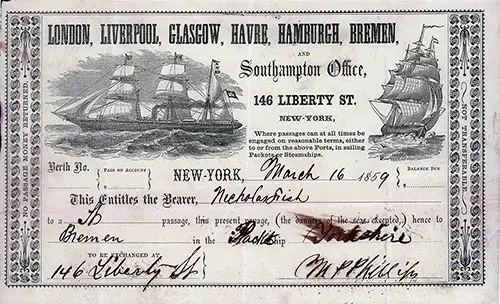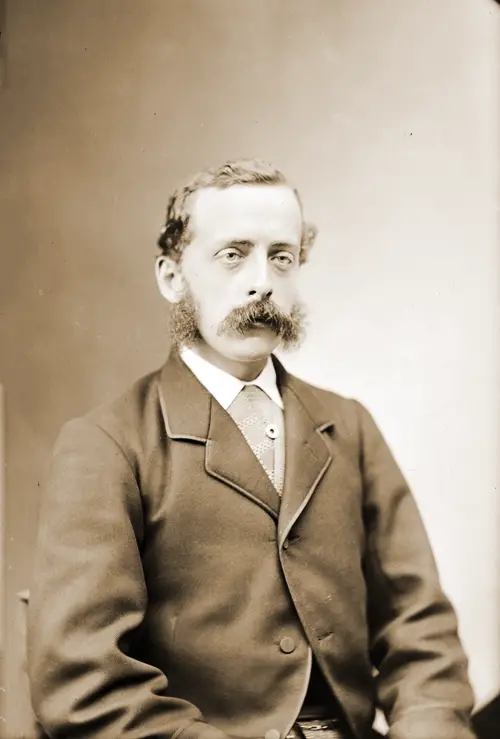SS Yorkshire Passage Contract - 16 March 1859

Passage Contract, on the Packet Ship "Yorkshire" of the Black Ball Line, 16 March 1859 - Nicholas Fish, New York to Bremen. GGA Image ID # 129a1313a8
Summary of Passage Contract
- Date of Purchase / Voyage: 16 March 1859
- Steamship Line: Black Ball Line
- Steamship: Packet Ship "Yorkshire"
- Route: New York to Bremen
- Ticket Type: Passage Contract
- Voyage Class: Unknown
- Name on Contract: Nicholas Fish
- Etnicity of Passenger(s): American
- Contract Terms: Not Stated
- Cost of Ticket: Not Stated
London, Liverpool, Glasgow, Havre, Hamburg, Bremen and Southampton Office,
146 Liberty Street, New York
Where passages can at all times be engaged on reasonable terms, either to or from the above ports, in Sailing Packets or Steamships.
Berth No. ___ New York, March 16, 1859
This Entitles the Bearer, Nicholas Fish to a "Fb" passage, this present voyage, (the dangers of the seas excepted,) hence to Bremen in the Packet Ship Yorkshire.
To be Exchanged at 146 Liberty Street
/s/ M. P. Phillips
Note: Nicholas Fish would have been 13 Years Old at the time of this voyage.
About the Passenger: Nicholas Fish

Nicholas Fish II, Ex-Minister to Switzerland, c1882, a Passenger on the SS Yorkshire of the Black Ball Line, 16 March 1859. GGA Image ID # 1f9a24af7b
Nicholas Fish II (1846-1902) was the father of the late Hamilton Fish of Roosevelt's rough riders, brother of Stuyvesant Fish, President of the Illinois Central Railroad, grandson of American Revolutionary War soldier Nicholas Fish and son of Secretary of State Hamilton Fish. Nicholas Fish II was a U.S. diplomat, who was appointed second secretary of legation at Berlin in 1871, became secretary in 1874, and was charge d'affaires at Berne in 1877-1881, and minister to Belgium in 1882-1886, after which he engaged in banking in New York City.
The photograph of the Hon. Nicholas Fish II dates from circa 1882 taken after he left his post as Minister of Switzerland. Photo courtesy of the U.S. Library of Congress.
His death as reported by the New York Times was after being assaulted by a man selling jewelry at a Saloon. Mr. Fish was at the saloon in the company of two women. Two men entered the saloon and began to quarrel with Mr. Fish. After some minutes, Mr. Fish started toward the door, the other man pursuing him. On reaching the street door, it is said that the younger man struck the banker, but not hard enough to fell him.
But in an instant, he struck him again, this time causing him to fall to the pavement on his head. He was taken to Roosevelt Hospital and regained consciousness long enough to agree to have an operation performed (trephining his skull). He died a half hour after the operation started at 2:45 am 16 September 1902 with Mrs. Fish at his side. Mr. Fish was 56 years old.
Information about this Ticket
- Date: 16 March 1859
- Dimensions: 12.8 x 19.5 cm
Note 1: Phineas P. Quimby of Belfast, Maine, created an apparatus that introduced a lever for the purpose of moving the rudder with the same length of tiller, through a given space with less turns of the wheel that can be done in any other way with the same pitch of screw. Mr. Quimby was issued Patent No. 7197 dated March 19, 1850 by the U. S. Patent Office.
